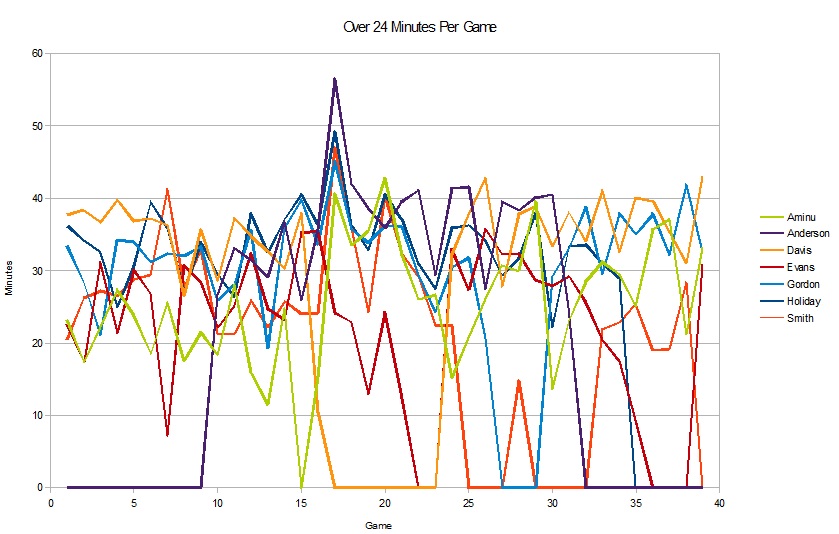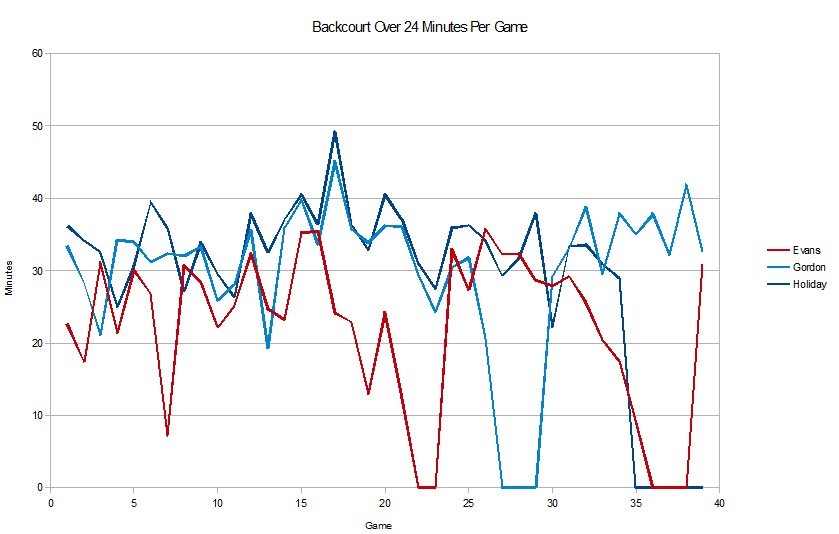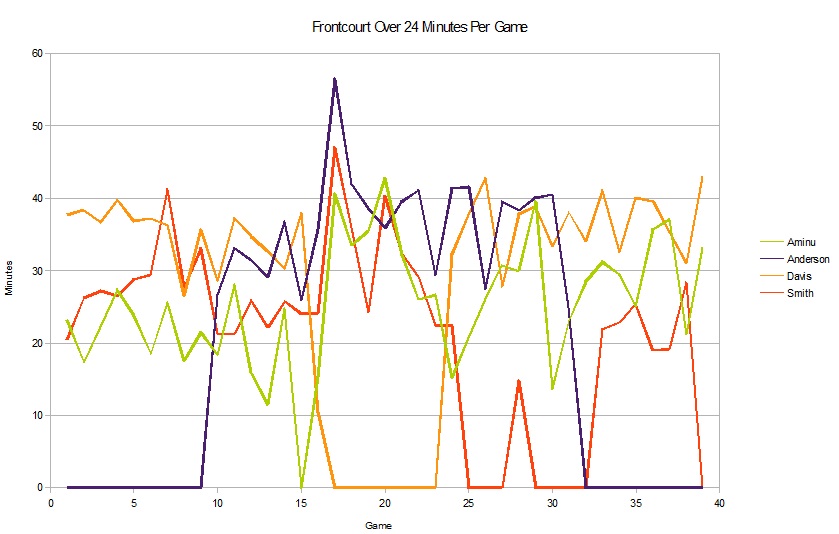Look at me now
I’m broken
Inherit my life— Pantera, I’m Broken
New Orleans Pelicans News
The one-game loss turned into a a five-game streak as the New Orleans Pelicans went 0-4 the week before last, including dropping both games of a back-to-back to the hated Dallas Mavericks. This dropped their record to 15-21, far from playoff contention in the West.
Prior to playing their first game of the week, it was announced that Ryan Anderson will be out indefinitely due to a herniated disc. The week closed with Tyreke Evans being held out with an ankle injury and Jrue Holiday being held out indefinitely due to a stress fracture in his right tibia.
The Pelicans had a good showing against the Heat before collapsing partway through the third, never recovering the in the fourth, eventually losing the game 107-88. A quick glance at the box score shows death by papercuts . . . getting outshone everywhere by a smidge . . . but when you factor in the 3PA differential (27 for the Heat, 9 for the Pelicans), it actually highlights a significant 2P% advantage for the Heat despite each team making the same 3P% . . . 1 of 3. The Pelicans were 33 of 68 for 2, a hair under 50% . . . the Heat, 31 of 51, or a shade under 60%.
Much is made of 3P% and 3PA, some for good reason, some out of faux intellectualism, but the Pelicans give up over 50% from 2 and are last in the NBA in this category; this can not be ignored.
The next loss was a 102-96 affair against the Wizards in which the Pelicans were unable to recover from a poor second quarter with a 4th quarter surge. As in many games, it’s not a matter of shots, but runs, and the second quarter opened with a 12-0 run for the Wizards in the first 4 minutes (Davis sat for around 90s, but played for the balance of that run), a 6-0 run for the Pelicans over the next 2 minutes or so, then a 9-0 run to take the quarter down to 3 minutes left. That’s a 21-6 9 minute period. Over the next 3 minutes the teams traded baskets with Wizards coming out 2 points ahead, 12-10. Giving up 12 points in 3 minutes to close the second is atrocious defense, even worse than allowing 21 points in 9 minutes.
After the 17-point lead creeped up to 21 to start the fourth, the Pelicans trimmed 2 off the lead in the first 4 minutes of the quarter, then both teams went scoreless until the Pelicans began a run with 6:36 left to play, eventually pulling to within 6 with 2:56 left to play. Over the remaining time, the Pelicans just could not string together enough stops and made shots to offset the deficit, missed shots, missed rebounds, and a turnover.
Andrew also made a video featuring pre-game, in-game, and post-game footage for this game.
The first of the losses to the Mavericks (I hate the Mavericks) was a fairly consistent drubbing (-7, -6, -6. +2 quarterly margins), leading to a 107-90 victory by the ponies. The efficiency difference was brutally wide . . . 0.615 v. 0.509 TS%. The AST% difference was also pretty head-turning . . . 0.780 v. 0.417.
The second of the losses to the Mavericks (I hate the Mavericks) was a was far less of a drubbing, with a final score of 110-107. While the Pelicans fell behind for a time, they led with under 4 minutes left to play and reduced the lead to 1 with 12 seconds left to play. The Pelicans only scored 1 field goal (a 3 from Miller) in that final 4 minutes, with Davis accounting for 5 points at the line. The hated Mavericks were not much better off, as their only field goal was a 2, but they scored 9 from the line. The Pelicans rebounded well, and it showed in this game.
This game also ended following an uncalled foul on a 3-point attempt by Rivers, as the NBA later affirmed. While Rivers’ FT puts his chances at tying the game well below 50%, making one of the first two and playing off an intentional miss with 0.6 seconds left. It would have been tough sledding either way.
Around Bourbon Street Shots
This week’s In the NO addressed the mounting injuries for the Pelicans . . . if they only knew!
Trew 2 the Game was a riff on what the team might have been doing as their trip had to altered due to weather in Indiana.
Staring into the face of the now-significant injury problem, Mason listed some possible adjustments the Pelicans could make to try to remain successful while Michael looked some numbers to keep in mind in case you what to know what good can be squeezed from failure.
`Voices’ of the People
I’m glad this article was posted. Just about every point is something I’ve been asking for as well (with exception to Morrow being traded, but I see the rationale).
It’s unfortunate that this is the turning point for the season, but if it’s the catalyst for the coaching staff to give opportunity to different lineups, then so be it. I think we need to give our young players (Withey, Rivers) way more time (and Miller can certainly use it too).
More importantly though, moving Gordon to the bench makes so much more sense without Ryno. Our bench has zero scorers now that he’s out. Tyreke is great, but he’s more of a utility guy than a first-option for scoring. Ryno and Gordon are, IMO, the go-to scorers on this team. Our bench sucks on offense, so why not inject some life into it with Gordon running point at times, taking it to the hoop or getting the 3?
I’d hate to see us tank the rest of the way and end up sitting in the 6th or 7th spot. There are a lot of worse teams than us that have been set from the start to be “Rigging for Wiggens” or whatever you want to call it. As much as I want to see us land Embiid/Wiggins/Parker I’d kind of like to see how our future core handles the set back. Plus we still have Gordon who we could possibly turn into someone else that compliments the team much better like a true center (like Pekovic or Asik) or a defensive wing player (Like an Avery Bradley, who by the way I really really want for us). Not that those trades will happen but we have a player with rising value and several throw in pieces as well. And as much as I don’t want to see him go if we can meet those needs by trading Anderson I’m open to it depending on the value we get back.
Basically I feel that our future is in a Holiday/Evans/Davis core with a 4th guy (be it Anderson or someone else). I feel that getting players with NBA experience will be more beneficial than risking on a college kid much less on even getting the slot. I want to see how the players that are going to be on the roster next season and beyond handle what their giving and develop through it. And I want to see Miller/Rivers/Withey more to see what happens with them. We have a lot of talent and a few assets to work with before we throw away an opportunity. The seasons not gonna be pretty but I’d be much more satisfied seeing development and effort than losing for possibly nothing.
— mrcatz22
Maybe it’s fun or interesting — well, perhaps only a little bit, I suppose — for fans and writers to speculate about how Dell Demps and Monty Williams ought to be doing their jobs. But mostly it’s comical. The worst idea being bandied about lately is that Coach ought to bench Eric Gordon from the starting lineup. That would be a disasterous decision that would make EJ virtually untradeable. Benching him would turn him into our Andrew Bynum. Remember how Saints Coach Jim Haslett benched QB Aaron Brooks at the end of the Hurricane Katrina season and then Brooks became a pariah that no team would trade for? At least in the NFL, Brooks’ contract was unguaranteed, so even though the Saints got nothing in exchange for the man who’d been their starting QB for several years, at least they weren’t stuck with a guaranteed contract. Gordon on the other hand should be the player all Pelicans fans are rooting for. We should want him to be one of the highest scorers on the team, stay healthy and keep his shooting percentages up. Otherwise, we’ll have to suffer through several years of a sulking, overpaid shooting guard with a guaranteed contract and redundant skills. Go, Eric Gordon! Play great every night as a Pelicans starter during the 2013-14 season. And then — as soon as possible — go to another team.
42 Sense
Injuries are inevitable. For the most part, the are unpredictable specifically, at least given the information most observers possess. An expert on stress fractures, their causes, and Jrue Holiday’s (prior) routine may have been able to point to an increased likelihood of him getting a stress fracture at this point in the season, but for the vast majority of us, the specific predictions are beyond our capacity.
An manageable problem, on the other hand, is looking at the effects (as opposed to the causes) of the injuries. Particularly, we can look at the minutes allocation in the wake of injuries.
Here is a graph of the players that average at least 24 minutes per game in the games in which they play. There are 7, and they are the 7 you expected: Aminu, Anderson, Davis, Evans, Gordon, Holiday, Smith.

The graph is a bit of a mess, but I present to both give an overall impression of what is happening with the major players and to establish that some graphs that are less busy in fact offer a clearer picture without losing (or hiding) something.
The main features are the stretches of players with 0 minutes (Aminu’s lone 0 minute game was due to coach’s decision) and the fact that players just are not being made to play over 40 minutes with regularity. Note that the spike is the Chicago 3OT game.
If you see something of value above that I don’t, feel free to let me know, and I’ll include it in the article. Below are graphs that simply split the one above according to frontcourt and back court. I stuck Aminu in the with frontcourt guys sort of arbitrarily since he’s not cleanly in either camp. He’s not a primary ball-handler, so that broke the impasse for me, and some observations below validated that choice.


In the backcourt graph, the correlation between Gordon’s and Holiday’s total minutes is most likely due to the fact that that they are often starters and closers. Evans’ differences appear to be due to his shortened games and his role as a bench player. What is most interesting is that when one of these players drops out of the rotation, or is severely limited, there is no corresponding increase in the minutes of the other players on the graph.
In the frontcourt, similar overall patterns exist with a couple of wrinkles. Smith seems to have been limited before being removed from the rotation due to his knee cartilage. Also, Aminu seems to be the beneficiary of some of Davis’ and Anderson’s minutes. Thinking about this for a bit, it seems to me that this is because Aminu may actually offer improved defense with less fouling compared to the other potential recipients of those minutes.
This leads into the main take away: When primary rotation players drop out of the rotation, the vast majority of those players’ minutes are being taken up by minor players rather than other major players despite there being room to do so in part.
Per game, Anderson was averaging 36.1 minutes per game, Davis averages 35.1 minutes, Holiday was averaging 33.6 minutes, and Gordon is playing 32.5 minutes. The rest of the roster is led by Smith’s 26.8 minutes per game. To me, this clearly establishes that there is room for other players to pick up some significant minutes from the major players that are sidelined (Anderson, Holiday, Smith).
Anderson’s 3-point shooting is, frankly, irreplaceable. He seems to be able to attempt 3-pointers that other players simply can not or do not attempt. Holiday is a fairly complete player, which is rarer that one might expect. In terms of basic roles, however, there are other major players that can fill in, at least to the tune of a few minutes per game, for their unavailable teammates.
This leads me to conclude that there are constraints that are preventing this avenue in the reallocations that injuries have made necessary. Since I have no knowledge of what these are, I have to speculate based on this data and other prior knowledge.
Evans seems to have an decrease in minutes before missing a batch of games. This could be an indicator that his ankle is a smoldering, ongoing issue rather than an intermittent one. His minutes could be an indicator of his ankle health, particular him playing below 25 minutes, if so. If true, it’s possible that the rotation where he plays a backloaded allocation is an accommodation for this condition. It’s also raises hopes for improved play next season and perhaps after the All-Star break. This would, however, explain why his minutes have not been increased significantly.
Contrary to what some of the less-than-data-driven claim, this franchise has had a fairly good record of developing players. Allocating minutes to players with less NBA experience is the only way those player who actually can improve to realize this potential. The players available to receive these minutes are not maturing rapidly before the eyes of fans, and this combined with their low initial performance level, makes for a steady, significantly worse performance than when the roster is fully healthy. Again, there is room for better players to play more, and that could make the difference in close games (4 of the last 8 had margins of 6 points or fewer), but this is not happening. A commitment to developing players to some extent could be driving this.
Additionally, overloading players with minutes is a way to invite more injury, just in terms being on the court more and perhaps in more desperate situations, for sure, but also in terms of season long fatigue and long-term wear-and-tear. With respect to Davis and Gordon in particular, playing extreme minutes will certainly result in closer games and more wins, but with players who have had the injuries these players have had (stress fracture for Davis, the knee issue / saga for Gordon), playing extreme minutes without having a solid season with only `random’ injuries under their belts first may be ill-advised.
The minutes allocation mot varying much could very well just be sticking to a long-term plan. If player X is supposed to play Y minutes per game this season, then they are just going to stick with that plan and let let roster and strategy flow around it. The Aminu minutes change may contravert this, but the frontcourt is the weakest unit, so maybe some small allowances are being made.
There could be other reasons, and this speculation could be way out-of-whack (as usual), but what I see, among other things, are conscious decisions to play worse players more often. Some will call it tanking, some will call it development, some will come up with other words. Whatever it is, I don’t see it changing significantly, but if this team wants to win (a little) more, it could.
You don’t try to win every game with every available resources. You pick your shots and weather the storm as best as possible until then. If they are simply convinced that to maximize the chances to win later are to play weaker players more now, then so be it. Question the goal, question the strategy, but I don’t think the execution can be questioned . . . there is a firm ceiling on the minutes allocations to major players.

6 responses to “The Increasing Costs of Healthcare”
I keep reading about how our franchise has a good record of developing players. While we have had some success, the benefits to this franchise have been limited. We have developed the following players who did not excel until they left here: Jack, Bellinelli, Pondexter, Lopez. None are far above average. We get credit for “developing” the following players who are currently below average (some well below): Vasquez, Jason Smith, Roberts. We have seen real improvement from Davis and Aminu, but I don’t know how much credit should go to coaches and how much to the players themselves. Rivers has improved slightly, but hardly a crowning achievement. We have had numerous guys pass through without improving: Gray, Thomas, Amundson, Okafor, Ariza, Anderson, etc.
Using advanced metrics, can somebody show me the evidence to back up the reputation that is being promoted here?
I’m in the middle of something else, but I offer to you: how many players were developed under Byron Scott, how many players were on their way out of the NBA before coming here, improved, and have gone on to do even better at what they developed here.
100% improvement is not needed To be good at developing players. I’m not sure 50% rate is needed to be considered good. Not great. Good. Many NBA players fail to score a second deal and acrually get minutes.
Even if I showed you fancy numbers, how do we attribute it case-by-case to “Monty?” I see quite clearly that these guys are better than what we had before and better than I see on a number of franchises.
Help me out with a framework that will be meaningful to you, and I’ll try to run the data down.
What good does it do to develop guys so that they can play on other teams? At this point would you rather have Bellinelli or Morrow? Lopez or Steimsma? Why do we make them better just to let them go? I guess so we can afford to give Gordon 15 million a year to lose with a bunch of crap role players we signed cheap to replace those guys we used to have who can actually play…
New City This seems like a completely different question plus some griping, which I’ll ignore.
The good it does is that a) they played better for you for a while compared to the way that they would have had they stayed stagnant, b) at some point the improved play will help you cash in on that improved value . . . see Tyreke and Withey for Lopez and Vasquez. Lopez’s value was quite low before coming to New Orleans and playing well.
You may not like that answer or the value the development got you, but it’s pretty undeniable that the deal does not work as a sign-and-trade without Lopez’s development.
Last time I checked Smith, Davis, and Aminu were on the team, too.
Jason CalmesThanks Jason.
Pick the 10 players you think best demonstrate the premise that Monty and staff improve players. Look at their performance by year before, during, and after (if applicable) their time with the Hornicans. I’f like that list to include Jack, Thornton, Vasquez, Lopez, and Smith. Personally, I can’t think of anyone since Posey (not Monty’s tenure) that came in here awesome and left playing worse, so we have that going for us.
I prefer Wins Produced or Win Shares as a way to evaluate players’ overall contribution. I’m okay with PER if that’s your preference. If you have a defensive metric you think is valid, throw that in. Per-36 or per-48 stats tell me more than per-game, but adding minutes/game would bridge that gap. Include a percentage change from year to year and cumulative, or a nifty graph….
Include a paragraph for intangible improvements that you think fail to show in the stat sheet, if you’d like.
If you really want to get deep into it, throw in by comparison some players from around the league that have improved greatly over the past 5 years, using the same metrics.
Other than win/loss record, this is about the only way to judge a coaching staff. I’m open minded about Monty, and would love to see the data.
Thanks for laying that out. I’ll have this in a week or two. I’ll stay as true to this as possible.
I’m open-minded to finding out that I’m wrong about that development or that it is in fact far below typical for an NBA team.
I’ve already started a look at the players with little NBA experience for a piece for today using other tools, so don’t mistake that as trying to slip an analysis past you.